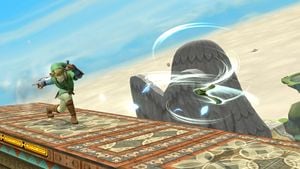Gale Boomerang
| Gale Boomerang | |
|---|---|
 Link using the Gale Boomerang in Smash 4. | |
| User | Link |
| Universe | The Legend of Zelda |
| Article on Zelda Wiki | Gale Boomerang |
Gale Boomerang (疾風のブーメラン, Hurricane's Boomerang) is Link's side special move in Super Smash Bros. Brawl and Super Smash Bros. 4.
Overview[edit]
The Gale Boomerang from The Legend of Zelda: Twilight Princess replaces Link's boomerang in Super Smash Bros. Brawl and Super Smash Bros. 4.
The Gale Boomerang is a useful tool for spacing opponents. One can tap the control stick while doing this move to increase its range, and tilt the stick up or down to aim it towards those directions. If the player dodges the Boomerang as it comes back to them, it will continue flying and curving towards the direction they dodged in. Link can only have one Boomerang on screen at any time; trying the attack again while a boomerang is out only results in Link doing his boomerang throwing animation without actually throwing anything.
When returning, the Gale Boomerang drags opponents towards Link, dealing no damage at all. If used properly, the player can string a number of different attacks following the boomerang's retrieving tornado. Link's side standard smash would be the most favorable attack of choice, as it would cancel the knockback allowing the second hit to connect. Link's down smash - if used with correct timing - can also damage opponents with both hits, causing a significantly larger amount of damage. Care has to be taken with this technique, though; as the Gale Boomerang doesn't do damage while dragging opponents, the opponent can also take the chance to prepare their own attack while being drawn towards Link. The Gale Boomerang is also capable of throwing large items forward and bringing small items toward Link.
If reflected, the Gale Boomerang automatically enters the second phase of its attack, meaning Link cannot be hurt by it, only pushed away by it.
The move can be used to perform Gale Guarding. If timed perfectly, one can ride atop on the Gale Boomerang.
Interestingly, the Gale Boomerang seems to cancel the landing lag from any of Link's aerial attacks if it returns to Link while he is on the ground after an aerial attack, most noticeably, his down aerial.
Instructional quotes[edit]
Customization[edit]
Special Move customization was added in Super Smash Bros. 4. These are the variations:
Link[edit]
| 1. Gale Boomerang | 2. Boomerang | 3. Ripping Boomerang |
|---|---|---|
| "Deals damage on its way out, and can pull opponents toward you on its way back." | "A normal boomerang with good attack power, but it won't pull opponents." | "A short-range boomerang that passes through opponents, dealing multiple hits." |
- Gale Boomerang: Default.
- Boomerang: A variation that lacks the wind effect, functioning identically to games prior to Brawl. It is stronger than the default version, but it loses the ability to pull objects and opponents towards Link.
- Ripping Boomerang: A short-range boomerang that passes through opponents, dealing multiple hits.
- In Super Smash Bros. for Wii U, this variation is a Challenge unlock, only obtainable by scoring at least 50 KOs in Endless Smash while playing as Link.
Gale guarding[edit]
Gale guarding is a technique in which Link uses the Gale Boomerang to prevent opponents from recovering. In order to perform Gale guarding, the opponent must be knocked off the stage. While they are recovering, the player must run, short hop or full jump off the stage, and then throw the Gale Boomerang directly at the ledge in a straight line. If done correctly, the boomerang will bounce off the stage, fly directly through Link, and pull the opponent away from the stage. This technique is best used against opponents with poor recovery.
A demonstration of Gale Guarding can be found here.
Glitch[edit]
A glitch may occur while Gale guarding in which the Gale Boomerang flies through the ledge and continues to fly through the stage, immediately entering its second phase. The boomerang will not return to Link, and instead will continue to fly on its path until it disappears. However, the boomerang will always be reusable even if this does occur, and it will only act as if Link had normally missed the boomerang on its return trip.
Origin[edit]
Boomerangs have been one of Link's main weapons since the very first The Legend of Zelda game; while generally inferior to the Bow as a means of indirect attack, it is reusable, capable of pulling items back to Link, stuns enemies, and triggers switches, making it more of a tool than a true offensive weapon; enemies such as Goriyas also possessed boomerangs as their main weapons as well. Some weak enemies could be defeated using the boomerang, and in some games the boomerang was capable of cutting down objects.
In The Legend of Zelda: Twilight Princess, the traditional Boomerang is replaced by the Gale Boomerang, which had the ability to summon tornado-like gales. The Gale Boomerang has the same uses as the traditional Boomerangs from the other Zelda games, but the Gale Boomerang could additionally turn fans and put out fires. The item pulling effect is not used in the Smash Bros. series.
Gallery[edit]
Names in other languages[edit]
| Language | Name |
|---|---|
| 疾風のブーメラン | |
| Gale Boomerang | |
| Boomerang Tornade | |
| Bumerán Tornado |







